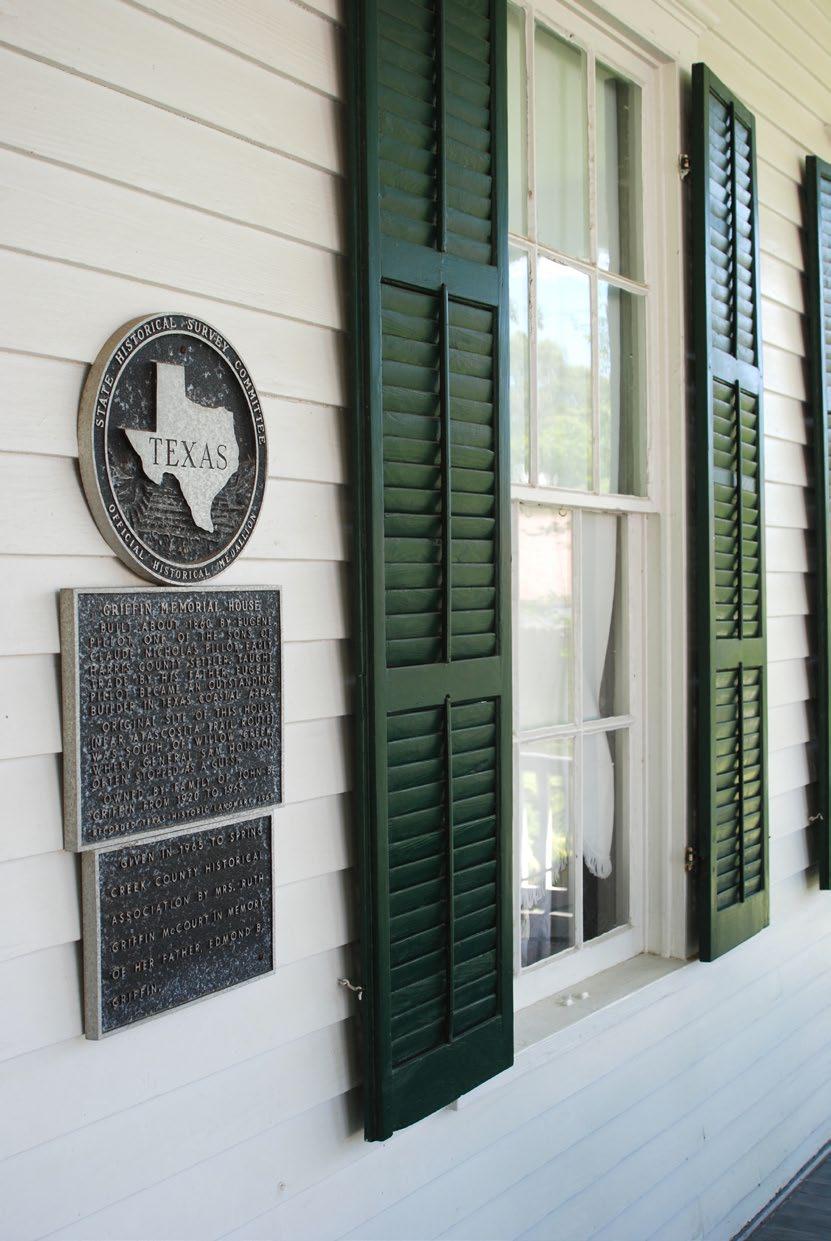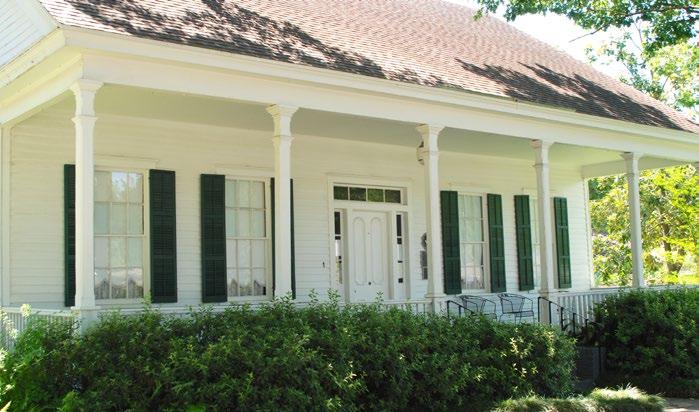
5 minute read
Precinct 4’s Top Historical Markers
compiled by Kaci Woodrome
1. BAYOU BEND
Advertisement
Location: 6003 Memorial Drive, Houston 77007. GPS: Latitude: 29° 45.540’. Longitude: 95° 25.307’.
Bayou Bend consists of an American heritage collection displayed in a mansion built in 1927 by William Hogg (1875-1930), Ima Hogg (18821975), Michael Hogg (1885-1941), and Thomas Hogg (1887-1949), the four children of the first native Texas governor, James Stephen (Jim) Hogg (1851-1906) and Sarah Ann (Stinson). William (Will) Hogg was an attorney and businessman who originated student loan programs in numerous Texas colleges. He served as chairman of the Board of Regents at the University of Texas from 1914 to 1916 and developed River Oaks where Buffalo Bayou makes a noted bend. Michael (Mike) Hogg was a Texas legislator from 1927 to 1931 who joined his sister in establishing the Hogg Foundation for Mental Health at the University of Texas. Miss Ima Hogg founded the Houston Symphony in 1913 and the Child Guidance Center of Houston in 1929. Additionally, she served on the Houston School Board from 1943 to 1949. Devoted to education and preservation, Ima Hogg provided Varner-Hogg Plantation State Historic Site in West Columbia and Winedale Historical Center in Fayette County. Miss Hogg and her brothers used their home, set on 14 acres of natural beauty and developed gardens, to house paintings and American memorabilia, which entertained national and international personages. The Hogg collection spans three centuries from about 1620 to 1870, containing several thousand objects installed in 28 period room settings. In 1957, Miss Hogg donated Bayou Bend and its treasures to the Museum of Fine Arts, Houston. Ticket prices range from $6 to $13 and can be purchased at www.mfah.org.
2. WUNSCHE BROTHERS SALOON & HOTEL
Location: 103 Midway St., Spring 77373. GPS: Latitude: 30° 04.768’. Longitude: 95° 25.052’.
The Wunsches, one of Spring's earliest families who immigrated from Germany in 1846, constructed this building in 1902. The Wunsche Bros. Saloon and Hotel, later known as the Spring Cafe, was built to accommodate railroad workers and has served as a community gathering place throughout the town’s history. The structure, which exhibits typical turn-of-the-century commercial detailing, is Spring's oldest existing commercial building on its original site. It was recorded as a Texas Historic Landmark in 1984.

3. KOHRVILLE COMMUNITY
Location: 18202 Theiss Mail Road, Klein 77379. GPS: Latitude: 30° 01.789’. Longitude: 95° 32.589’.
In the 1870s, former slaves from Alabama and Mississippi settled on Cypress Creek near a store owned by German immigrants Agnes and Paulin Kohrmann, where Paulin served as postmaster. The Kohrville community centered on the farming, ranching, and lumber industries. In the early 1900s, a cotton gin and sawmill were present, and Agnes Kohrmann ran the general store that served a reported population of 50 residents. By 1911, the post office had been discontinued and mail was being delivered from Hufsmith. When area schools consolidated, Kohrville became part of Klein Independent School District and offered education for white and black students. In the late 1940s, Klein ISD financed a new school for the community. An architect, probably Alfred C. Finn, designed the new schoolhouse, which was later moved to the current site. The school district was desegregated in the 1960s. Kohrville and neighboring communities are now part of the ever-growing Houston suburbs. The Kohrville community was designated as a Texas Historical landmark in 2003.
4. LAMBRECHT’S ARTESIAN WELL
Location: Business F.M. 1960 (First Street) at North Houston Avenue, Humble 77338. GPS: Latitude: 30.00.107’. Longitude: 95. 15.305’.
An oil well drilled at this site in 1912 yielded not oil, but free-flowing artesian water. The following year, German native Nick Lambrecht (1855-1920) purchased the property. Lambrecht served as justice of the peace and mayor during Humble's oil boom days in the early 20th century. In 1904, he installed a water system to meet the needs of the many oil field workers who came to town. Lambrecht's artesian well was used to supply water to bathhouses and piped to nearby homes. In earlier years, water had been hauled to town in barrels on horse-drawn wagons.
5. OLD TOWN SPRING
Location: 403 Main St., Spring 77373. GPS: Latitude: 30° 04.733’. Longitude: 95° 25.327’.
Initially a farming community supported by sugar cane and cotton crops, Spring was platted by the Houston & Great Northern Railroad in 1873. That same year, Callahan Pickette became the town's first postmaster. Spring served as the commercial center for the surrounding area during the early 1900s and a focal point for German settlers including Carl Wunsche, who was instrumental in the town's development. A new rail line reached Spring in the early 20th century, and the addition of a roundhouse and railway shops created an import rail center for the growing community. Developer R.l. Robinson subdivided land south of the original town and the commercial area shifted to accommodate the rail junction. Railroads facilitated the development of the lumber industry, which boasted large and small mills during the boom era of lumber production. With the boom came new businesses, including hotels, saloons, an opera house, gambling houses, a hospital, and a bank. In 1907, residents established the Spring Independent School District. The loss of the roundhouse and the onset of Prohibition led to a decline in population. Ultimately, the saloons, hotels, and other rail-supported businesses closed in the 1920s. The dwindling community persisted, however, creating a volunteer fire department in the 1950s and sustaining the Spring ISD, which integrated in the mid-1960s. As the population began to grow again in the early 1970s, many new businesses opened, including a variety of specialty shops. Spring continues to attract new residents and businesses but retains its unique identity as a town with a strong German heritage and its link to early history. The town of Spring was designated as a Texas Historical landmark in 2003.
6. GRIFFIN MEMORIAL HOUSE


Location: 510 N. Pine St., Tomball 77375. GPS: Latitude: 30° 05.939’. Longitude: 95° 37.176’.
Tip: At the corner of Pine Street and Epps Street across from the Tomball Museum.
Built about 1860 by Eugene Pillot, son of early Harris County settler Claude Nicholas Pillot, who became an outstanding builder in the Texas coastal region after learning the trade from his father. The original site of the house, near the Atascocita Trail route and south of Willow Creek, was often visited by General Sam Houston. The family of John B. Griffin owned the house from 1920 to 1995. Mrs. Ruth Griffin McCourt gave the home to the Spring Creek County Historical Association in 1965 in memory of her father, Edmond B. Griffin. The Griffin Memorial House was recorded as a Texas Historic Landmark in 1969.

